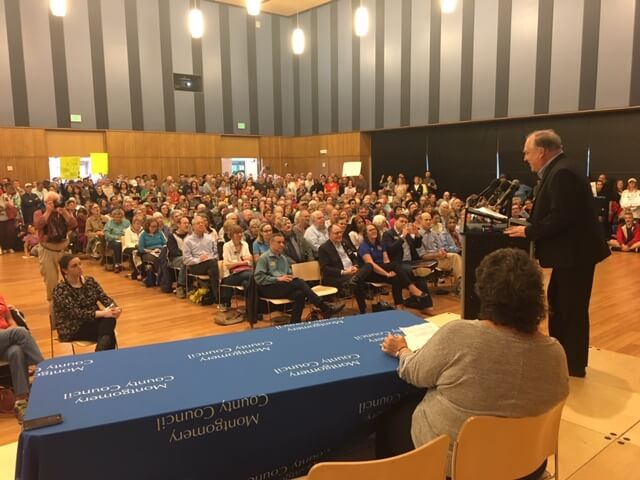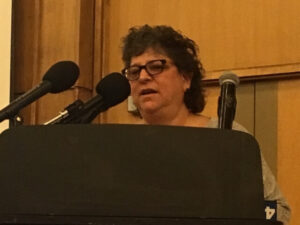As Highway Expansion Foes Pack Town Hall, Hogan Hits Back on Twitter

The approximately 750 elected officials, activists and citizens who packed Sunday’s Beltway/I-270 Town Hall in Montgomery County had reason to wonder whether their messages of opposition to Gov. Lawrence J. Hogan Jr.’s road-widening plan would reach Hogan himself.
They need not have worried.
About an hour in to the two-hour gathering, the governor took to social media to defend the state’s proposals — and to call into question the motives of those gathered at the Silver Spring Civic Building.
In one tweet, he referred to “anti-congestion-relief activists.”
Montgomery County Councilmember Tom Hucker (D), the organizer of the event, immediately read portions of Hogan’s posts off his phone. They were not well received by the standing-room-only crowd.
The audience had just cheered as County Executive Marc B. Elrich (D) derided the state’s plans to widen the Capital Beltway and Interstate 270 two lanes in each direction as “seriously wrong” and “stupid.”
“It’s flat-out a mistake and it’s not gonna work,” he said.
Elrich offered a detailed critique of the state’s plans:
— He believes Maryland should begin its traffic-relief efforts at the American Legion Bridge (“the big bottleneck,” he called it);
— He has urged the state to re-stripe the existing pavement in the 270 corridor to add additional lanes;
— He wants two reversible lanes on 270 rather than two lanes in each direction, to reduce cost and the likelihood that homes will be taken; and
— He thinks the state’s Beltway plan is particularly ill-advised because of what he called the need for massive on- and off-ramps at Georgia Avenue, New Hampshire Avenue and other state roads that intersect I-495.
Elrich said the LBJ Memorial Highway in Houston was a case-study of why Maryland’s approach is flawed.
“Look at the interchanges,” he said. “There is no way… you’re going to get people off [the highway], because the ramps and the things that are required to accommodate the LBJ Memorial Highway would knock out every neighborhood at every intersection along the Beltway.”
The audience also heard from representatives of nearly a dozen environmental and civic organizations opposed to the state’s plan, and from Carol Rubin, the special projects manager for the I-495/I-270 Managed Lanes Study, who co-wrote a scathing letter to the Maryland National Park and Planning Commission.
They argued that adding lanes doesn’t ease congestion, that the state’s plans would result in the loss of homes and parkland, that noise would increase and that stormwater issues would intensify.
They accused state planners of trying to rush the project through to avoid public scrutiny, of using old data and of ignoring both public comment and input from local experts.
“I’ve been trying to tell the State Highway Administration, ‘please respect our local planning.’ But it seems like the only thing they’re interested in is what we have to say about how we’re going to mitigate the parkland that’s going to be transferred, and that’s a done deal, at least from their perspective.
“This is all about political will that is coming from the ground up.”
Her memo to the MNCPPC surprised veteran officeholders for its boldness, and the low-key planner was direct in her appeal to the state.
“The real way to design a project of this magnitude is to look at the relationship with existing origin and destination patterns, planned land use, economic development considerations, social equity, and safe and efficient access to transit facilities.”
The Hogan administration has said repeatedly that, by using a public-private partnership to fund and build new lanes on the frequently-congested roads, the state is tapping the smartest engineers in the world to solve Maryland’s commuting woes. They have also said that Maryland lacks the bonding capability to fund the road-widening — estimated at $9 billion to $11 billion — without the private sector’s deep pockets.
But Rubin accused state transportation officials of misleading the public about how the process works.

Carol Rubin, a Montgomery County planner who has been critical of the Hogan administration’s approach to widening the Capital Beltway and Interstate 270, received a hero’s welcome at Sunday’s town hall in Silver Spring. Photo by Bruce DePuyt
“Whenever the State Highway Administration says, ‘Well, the P3 is designing this project, or the P3 is going to do the analysis, they’re giving messages to the P3. By taking transit as a critical element in any of the alternatives… off the table, they have sent a message to the P3 that transit doesn’t matter.
“And that’s what we’re trying to avoid.”
(Rubin, who was greeted with raucous applause by the wonky audience, called the attention “a little embarrassing.”)
Although most commuters get to work by car, many speakers said the state was failing to note a generational shift in how people get around.
Maryland’s plan “ignores the attitudinal shifts among a population that wants mass transit, mixed-use development, [and] walkable as well as environmentally-friendly modes of transportation,” Dayo Akinsheye of Our Revolution Maryland said.
Several speakers claimed that recently-released documents from the state Department of Transportation confirm that taxpayers will be on the hook if any of the firms contracted to build new lanes fails or if the project can’t get insurance. They consider that another broken promise from Hogan — alongside his pre-election assertion that no homes or businesses will be taken to expand 270 and 495.
Hogan took to Twitter during the town hall to reaffirm the state’s plans.
“While these activists plot to keep the roads filled with traffic, our relief plans have received broad support, advancing through public hearings, workshops, meetings & votes. We’ll continue our historic investment in both transit & roads so that you can finally get moving again,” he said in one message.
Moments later, another message read: “These anti-congestion-relief activists show no regard for the hundreds of thousands of you who are stuck in soul-crushing traffic every day; even more, they offer no real ideas to solve a public health, environmental & safety crisis that is hurting quality of life in the region.”
Elrich conceded that Hogan — one member of the three-member Board of Public Works — is likely to support the project moving forward. But he and other speakers pledged to lobby the other two, Comptroller Peter V.R. Franchot (D) and Treasurer Nancy K. Kopp (D).
Both are former state lawmakers from Montgomery County. Franchot lives in Takoma Park, Kopp resides in Bethesda.
In addition to his belief that MDOT should move first to widen the American Legion Bridge and I-270, Elrich raised the concern that Maryland is lumping the two projects together because 270 tolls may be needed to make the more expensive Beltway project financially viable for the private sector.
“They can suck the money off I-270 to underwrite the costs of 495, which are just going to be extraordinary,” he said.
He expressed gratitude that so many people showed up on a rainy Sunday to protest the state’s plans.
“A larger group of angry, upset people is an improvement,” he said. “And I’m a big believer that you stop things and you build movements from the bottom up.”
Hucker said he was surprised by the size and intensity of the crowd. “I’ve been in this building for 150 events; I’ve never once seen this room this full … We organized it on a week’s notice. The reason so many people came out is they are scared to death of the governor’s ill-conceived, reckless project.”
He also faulted Hogan for tweeting in real-time, rather than sending staff.
“It’s a very bad look for the governor to be sitting in that big house and tweeting at activists who are nervous that their environment is being compromised, their neighborhoods ruined, and their houses, in some cases, could be taken.”
A Hogan spokesman declined to comment.
An MDOT official disputed Hucker’s claim that the agency was invited to his town hall.
In addition, a spokesman for Hogan noted that the capital region has some of the worst traffic in the nation and that a recent poll found traffic congestion to be the top concern of Montgomery County residents and the second-highest concern in Prince George’s.
The spokesman said the state’s ongoing public workshops offer residents an opportunity to learn about and comment on the administration’s plans.
Last week, the governor agreed to defer a vote on the P3 program, set for the May 8 meeting of the Board of Public Works, to allow for Kopp to return from an overseas trip with her husband. The pair are on a long-planned trip to celebrate their 50th wedding anniversary.




 Creative Commons Attribution
Creative Commons Attribution